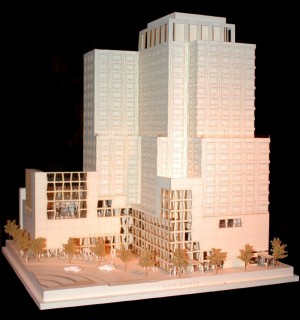The 187-Year-Old Lady Gets a Facelift and an Opening
The historical elegance of the second and fourth floor galleries proves that the initial promises were kept. Architectural details such as crown moldings, door frames, and fireplaces have been retained to preserve the residential ambiance of the townhouse. Full-height hanging walls are now suited to large-scale works and new lighting will provide the flexibility for displaying all types of media.
The overall impression one gets, strolling through rectangular, oval, and round galleries of inviting proportions is one of a privileged guest rather than an anonymous visitor.
The building extension at 3 East 89th Street was also part of the renovation (this opened as part of The National Academy in 1942 after the Huntingtons deeded it as well as the original Fifth Avenue home for one dollar). The 5 East 89th Street building also was given a new vestibule and open lobby to support student exhibits. U-shaped partitions allow the lobby and adjacent Assembly Hall to be subdivided into work spaces and the hall will now accommodate 200 people for lectures and workshops.
The Annual Exhibition – January 25, 2012 to April 29, 2012
Advertised as an exhibit with “cross-generational connections in contemporary art and architecture,” this show definitely exhibits something for everyone, as the adage goes. Such egalitarianism can lead to watered-down expectations in some instances, but in this case, the overall level of excellence holds firm.
And it’s refreshing to take in each gallery space at a leisurely pace, not being overwhelmed again and again by the “shock of the new” in art critic Robert Hugh’s coinage. There’s respect for the figurative and the surreal, along with pop throwbacks and hardline abstractionism. One also gets the feeling there’s respect among the younger participants to honor the traditions of forbearers, even if it means giving their own attempts a new, and sometimes, quirky twist. Women are generously represented, in line with the Academy’s gender-free approach.
Video installations make that position very clear, with entries by the front-line artist Joan Jonas’ Lines in the Sand, an evocation of Imagist poet H.D.’s Helen of Troy to present-day Las Vegas. Carrie Mae Weems in Afro-Chic does a three-channel exploration that explores the runway model personality with an African-American slant. Kate Gilmore’s videos in Break of Day show the artist deliberately destroying objects, repeating a seemingly senseless task. What the viewer takes away after this confrontation may read as meaningless, and a bit disturbing, as the performance art itself.
Philip Pearlstein’s contribution to figurative painting over the last 50 years needs no introduction. In Model with Ostrich, Eagle, and Duck, one gets the front-on confrontation with his nude, but here, the focus is almost non-existent, as the eye roams over the model on the far left of the canvas to take in tchotchkes, such as a Walt Disney-inspired Donald Duck, an ostrich, and an Eagle. Why should we care? An equalizing mediocrity in modern culture prevails, and perhaps, is statement enough. Ellen Alfest’s obsession with The Leg, a meticulous oil painting is in danger of being almost overlooked, and challenges the approach to the traditional human figure painting.
Figurative representation with an unidentifiable story struggling to emerge exists in the work of Alan Feltus; The Young Man and the Flower Lady, frozen in the frame, stares outwards with a disturbing alienation reminiscent of Balthus. Mary Beth McKenzie’s Christian and Ivy, gives us another couple in a position of lassitude, a fragmentation in the brush strokes that suggests the imminent downfall of this pair.
Sculpture is presented most boldly in Smokin’ Papa Chaud by Alison Saar; an iconic black man created from wood, tin, and found objects. Saar is a 2011 inductee to the Academy who has made a name for herself as a powerful black artist with a West Coast heritage.
In architecture, Laurence O. Booth has created The House on Lake Michigan, an architectural model of such singularity to its environment; it calls to mind the specter of Frank Lloyd Wright’s most signature environmental home creations. Jeanne Gang, one of the younger architects represented, has presented a computer-generated rendering of Blue Wall Center in Greenville County, South Carolina. Gang is a recent MacArthur Fellow and a trailblazing Chicago architect. But the stand-out entry is Robert Stern’s model of the new Museum of African Art, which is due to open in fall 2012.
According to Curator Marshall Price, there are only nine architects represented, but that matches the percentage of architects in the membership.
Leaving the spare, snow-white lobby of the Academy, I am reminded of an old fairy tale: “Mirror, Mirror, on the Wall, who’s the fairest of them all?” I think we know the answer.
For more information on the exhibit, please visit http://nationalacademy.org.


